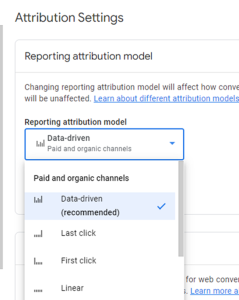What You Need to Know About the Data-Driven Attribution Model In GA4
First click, linear, time decay, and position-based attribution models are going away across Google Ads and Google Analytics
- Starting in May 2023, Google will remove the ability to select first click, linear, time decay, and position-based attribution models for conversion actions in Google Ads that do not already use one of these models.
- Starting in September 2023, these four rule-based attribution models will be removed from Google Ads and Google Analytics.
What happens to conversion actions if these attribution models are removed?
Once these four attribution models are removed in September 2023, they will also be removed from the reporting throughout the rest of Google Analytics, including the Overview page and the Model comparison report within the Attribution tab.
Any conversion actions still using these models will be switching automatically to data-driven attribution, the default attribution model moving forward. If you want to continue using the last-click attribution model, you have the option to manually switch to the last-click model. To do that, you would need to access the Attribution section in GA4, which can be found in the Admin tab.
What is the Data-Driven Attribution model?
Data-driven attribution takes into account the actual data collected on customer interactions and behaviors to determine the impact of each touchpoint on the conversion or desired outcome. It utilizes statistical models and machine learning to analyze large sets of data and identify the relative contribution of each touchpoint.
Attribution Reportings in GA4
There are two main reports in GA4, the model comparison tool and the conversion paths report, which can be found in the attribution reports sections.
With the model comparison tool, users can analyze how conversion credit shifts under different attribution models and assess how these models impact the evaluation of different marketing channels. The tool presents data in a table format for conversions and revenue, offering a clear view of these metrics across different channels and different attribution models. For instance, one can compare data from the Last-Click Model with that of the Data-Driven Attribution Model. The model comparison report can help users understand how different models attribute conversions to various touchpoints, before altering the attribution settings in GA4.
The conversion paths report, similar to the funnel report in Universal Analytics, provides the option to switch between various attribution models. This report offers valuable insights into the channels within a multi-channel conversion path, allowing for a deeper understanding of customer journeys.
Potential Concerns Regarding the Attribution Model Update in GA4
The key advantage of data-driven attribution is its ability to provide a more accurate and granular understanding of the customer journey. By considering multiple touchpoints and their interactions, it can reveal the true influence and value of each touchpoint in driving conversions or desired outcomes.
In the meantime, we believe that removing the four attribution models and defaulting to the GA4 data-driven model may lead to an increase in reporting complexity. Rule-based attribution models provide clear and straightforward insights into the contribution of specific touchpoints. They offer a simplified view that makes it easier to understand and communicate with stakeholders. On the other hand, data-driven attribution models can be more complex and make it challenging to pinpoint the channel that is truly driving conversions. Furthermore, since these models necessitate advanced statistical analysis, they may require a substantial amount of data to deliver the most accurate results.
Other Challenges
The removal of these attribution models may pose challenges in comparing future data with past performance, as the change in the attribution model could introduce discrepancies. The discrepancy in data resulting from the change in the attribution model could hinder the ability to make “apple-to-apple” comparisons and evaluate the effectiveness of marketing efforts over time.
As new features, such as the attribution models and reports, emerged with the new GA4 platform, it is strongly recommended to set up your GA4 prior to the deadline and familiarize yourself with the platform. If you require any assistance in migrating to GA4, please feel free to reach out to us using this form.






